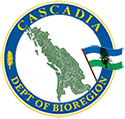The 2015 Cascadia Map by David McCloskey and the Cascadia Institute was featured by ESRI on their front cover.
Creating maps or conducting spatial analysis for the Cascadia Bioregion or other transboundary international regions is often very challenging because datasets are frequently restricted to a single country, state/province, or other political boundary. Datasets from different sources may not line up spatially or cover the same time period and often use different categories, units, or definitions for the variables they record.
The Cascadia Department of Bioregion is excited to partner with the University of Washington GIS Certificate program to work with a team of students to develop Cascadia related applications. This is also very exciting in that the Department of Bioregion just received our nonprofit ESRI ArcGIS online and desktop versions, so getting these set up and functioning to be able to pull data will be a huge boon for students and volunteers.
Our hope is to achieve a similar goal, or combine forces with the Cascadia Bioregional Atlas being developed by Aquila Flowers and Western Washington University: https://wp.wwu.edu/cascadia/
Geographic information systems (GIS) combine the age-old science of cartography with powerful spatial database technologies to model the real world, perform data analytics and inform decision-making processes. These systems have countless applications in private industries, government agencies and academia, and are continually being used in new ways to change our understanding of the world around us.
A bioregion is a “bio-cultural region” defined by the natural geographic boundaries of ecosystems, watersheds, and human communities, rather than by political boundaries. Bioregions are a powerful concept for organizing regional identities and guiding locally appropriate management decisions. The Cascadia Bioregion encompasses the Columbia and Fraser watersheds, as well as other adjacent watersheds draining into the Pacific Ocean.
In the UW certificate program, students gain in-depth knowledge about GIS and the diverse workplace applications for these systems. They examine the range of information sources that can be combined to build a GIS database, including raw data, scanned maps, GPS positions, aerial photography and other imagery. And lastly, how these systems are used to support research and business activities in a variety of fields, including land-use planning, transportation, environmental sciences, social sciences and disaster preparedness.




Post a comment